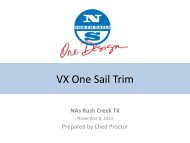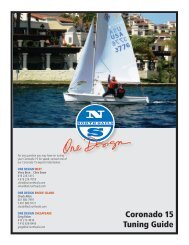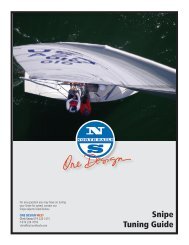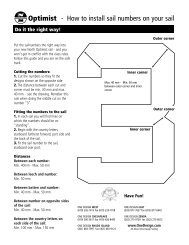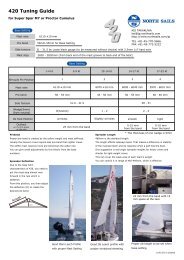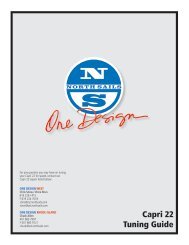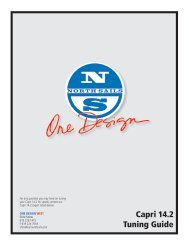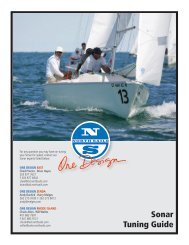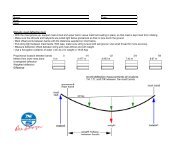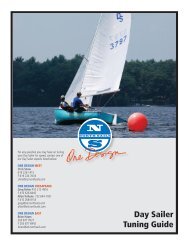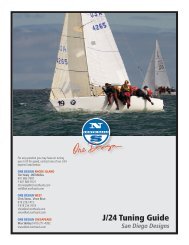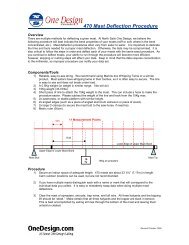470 Tuning Guide E01 - North Sails - One Design
470 Tuning Guide E01 - North Sails - One Design
470 Tuning Guide E01 - North Sails - One Design
You also want an ePaper? Increase the reach of your titles
YUMPU automatically turns print PDFs into web optimized ePapers that Google loves.
Main Sail<br />
Leech Ribbons<br />
The top Leech ribbon is sign of sail twist<br />
at under 4m/s condition.A ribbon flowing<br />
constantly means too much twist, and<br />
stall means too tight twist. You should<br />
control the leech to keep the top ribbon<br />
flowing at 50%~80% ratio (middle and<br />
bottom ribbon should be flying constantly).<br />
Outhaul<br />
Outhaul can be eased 10mm~15mm from<br />
inner black band under 0~5m/s condition.<br />
If you need power in bad wave<br />
conditions,the outhaul can be eased to<br />
10~25mm.Over 5m/s condition,when you<br />
feel overpowered a little,you should pull<br />
the outhaul to the black band.The mainsail<br />
tack should be touching the aft face of<br />
the mast when you are getting back<br />
wind.(refer to the section about the<br />
mainsail tack rope.)<br />
Cunningham<br />
When you pull the cunningham,the draft<br />
position will be moved forward and the<br />
leech will be opened giving a flatter<br />
shape.As the wind increases,there is a<br />
tendency that the draft will move aft.So<br />
you should pull the cunningham to get the<br />
proper draft position.In maximum wind<br />
condition,you must pull the cunningham<br />
harder until the ring is sitting near the tack<br />
position.<br />
Tack Rope<br />
Peak<br />
You should adjust the main halyard length<br />
so that the peak of mainsail(upper edge<br />
of head board) is the same height as<br />
lower edge of the mast top black band .<br />
Mainsail has cutback tack for more wider<br />
control of depth:<br />
fullpower -- set sail edge at tack 10 mm<br />
apart from backside of mast .<br />
overpower -- set sail edge at tack nearby<br />
the mast when backwind appears.<br />
It`s important that you<br />
should hoist the main<br />
halyard to this position<br />
for measuring mast<br />
rake.<br />
fullpower - set sail<br />
edge at tack 10 mm<br />
apart from backside of<br />
mast .<br />
overpower- set sail<br />
edge at tack nearby<br />
the mast when<br />
backwind appears.<br />
Tack Rope and Outhaul control<br />
Condition<br />
0m/s~Full Trapeze or just before<br />
(no vang)<br />
Full Trapeze ~ use some vang<br />
Boom is constantly out of boat<br />
Tack Rope<br />
(Mast side)<br />
10mm apart<br />
10mm apart<br />
0mm<br />
Outhaul<br />
(Black Band)<br />
ease 10~15mm<br />
pull until at the<br />
black band<br />
pull until at the<br />
black band<br />
Jib Sail<br />
Example<br />
Trim Line<br />
When Jib track position is right and you<br />
luff up the boat, all telltales will respond at<br />
the same time, because of effect of<br />
backwind at luff. Our sail includes a trim<br />
line which makes the lead angle easy to<br />
find up to full power sailing. This trim line<br />
shows proper track position when trim<br />
line and jib sheet is on the same line. This<br />
means good jib sail trim (middle batten is<br />
parallel to boat center line).<br />
The trim line supports your lead angle trim<br />
up to full power sailing. When you feel over<br />
power from increasing wind speed, you<br />
should move the track position aft in relation<br />
to sail power. It is necessary to open<br />
leech in accordance with<br />
keeping a proper slot between main and<br />
jib, because over-sheeting the jib causes<br />
the main boom to be eased too far in order<br />
to reduce heel. This means lower<br />
pointing.<br />
<strong>Tuning</strong> Data Example<br />
Wind range<br />
Mast rake<br />
0 0~4m/s 6750mm Light Wind Special<br />
1 0~6m/s 6720mm<br />
>1/2pin shorter<br />
2 7~9m/s 6690mm<br />
>1/2pin shorter<br />
3 9~10m/s 6660mm<br />
>1/2pin shorter<br />
4 10m/s~ 6630mm<br />
Full Power<br />
We define the Full Power Condition as the<br />
situation where we can keep the boat flat<br />
without the loss of wind power and hold<br />
the boom in the center with full trapeze.<br />
It`s important to tune the mast to derive<br />
as much thrust as possible.<br />
You should control the mast bend to deal<br />
with overpower and underpower condition.<br />
<br />
Peak Rope<br />
If you hoist the jibsail higher, it makes more<br />
gap between the sail foot and deck. Wind<br />
which flows under the jib foot is turbulent<br />
and causes loss of efficiency. You should<br />
adjust the peakrope so that the jib foot<br />
just touches the waterbreak at full power<br />
sailing. At this height, it makes the most<br />
effective sail area with end-plate effect of<br />
foredeck and less overlap of mainsail.<br />
Tack Rope<br />
<br />
You should use only light tension up to the<br />
middle wind range (4m/s). There should<br />
be almost no tension on the sail material<br />
behaind luff tape.Too much tension<br />
makes the entry angle too wide<br />
and can damage the material which has<br />
a biased orientation at this edge. In strong<br />
wind, try to keep the creases out of the<br />
luff.



